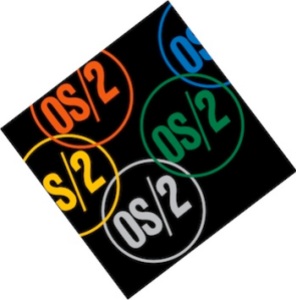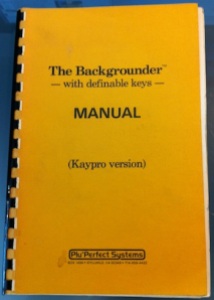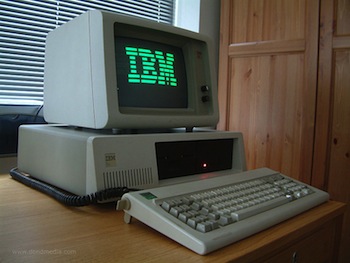As I read through the Steve Jobs biography I was reminded of an article that I wrote in 1987 for one of my journalism classes. Several years into my own micro-computer adventures I was intrigued by IBM’s hard-right-turn, having captured the small computer market, to try to make it completely proprietary with it’s proposed OS/2 operating system and PS/2 hardware. Besides reading scores of books and articles on recent micro-computer history, I interviewed several local micro-computer vendors. I love how they felt that multitasking systems, what OS/2 was supposed to do, would be too complicated and just not necessary. At the end of the article I’ve posted a video from this era, from the Computer Chronicles TV show. Enjoy
Is The IBM PC/XT Doomed To Be Technology’s Next Dinosaur?
by Joe Bustillos – November 17, 1987 – CSUF COMM201 – Feature Article #2
On April 2, 1987 IBM (International Business Machines) introduced a new line of microcomputers and an operating system for their micros that will be incompatible with the original IBM Personal Computer and its operating system (MSDOS). An operating system is an essential program that makes up the “brains” and “personality” of a computer. It enables the computer to “talk” to its disk drives and its screen and it’s what the computer user “talks to” when he types on the keyboard (and you thought nobody was listening). If two computers from two manufacturers, for example AT&T and Compaq, are running the same operating system (MSDOS) chances are pretty good that a word-processing program that works on one computer will work on the other computer.
 But IBM’s new operating system, OS/2 (Operating System, version 2) will not run on what makes up the bulk of all IBM microcomputers in use today, the PC/XT-class micros. (OS/2 will work on the newer AT and 386-based machines and of course the brand new PS/2 computers that IBM has just introduced).
But IBM’s new operating system, OS/2 (Operating System, version 2) will not run on what makes up the bulk of all IBM microcomputers in use today, the PC/XT-class micros. (OS/2 will work on the newer AT and 386-based machines and of course the brand new PS/2 computers that IBM has just introduced).
Much heated speculation has been generated in the computer press both before and after the announcement about what this will mean to the hundreds of IBM-clone manufacturers, retailers, and support businesses who continue to put out thousands of PC/XT-class machines per month. There is also concern about what this will mean to the estimated six to nine million computer users who currently own IBM PC/XT-class systems.
Will these six to nine million computer users scrap their present systems and invest another $6000 plus to upgrade to the new hardware and software? Will the PC/XT clone manufacturer find himself with several thousand systems in stock and no one interested in buying one? We’re talking about the future of hundreds of garage-based computer operations who have hopes of becoming the next Apple Computer. Fortunately for those who would try to predict the outcome of this tale of computer intrigue and marketing bad luck, there is an historical precedence to look to.
During the latter 1970s, when IBM was busily occupied being the king of the white-robed mainframe computer priesthood, the microcomputer market, which was still in its infancy, was united under one operating system called CP/M (Control Program for Microcomputers). Having computers from different manufacturers run the same operating system was quite a different approach from that of the mainframe and minicomputer industry where each manufacturer had his own proprietary operating system and application software (word-processing and billing programs). Because the microcomputer industry was basically dozens of small no-name electronics firms, they saw the cost effectiveness of producing computers that ran under the same operating system.
If a computer user had a word-processing program that worked on an Altair, for example, chances were, if the Altair ran under CP/M, that his program would work on a Cromemco or North Star or CompuPro, provided they were running under CP/M. Even Apple computer, with its radically different system architecture, found a way to run under CP/M and eventually became the largest base of CP/M systems.
Being under one operating system propelled the microcomputer market forward. It encouraged programmers to write new and more advanced programs because they would be able to sell their work to computer users of more than one machine. This, in turn, encouraged more people to buy the micros to run the “useful” programs, which encouraged the development of more programs. Back before 1981, microcomputers were a happy growing cottage industry. But this growth and potential revenue attracted the attention of someone else.
So in August 1981 IBM introduced its PC (Personal Computer). But rather than bring itself under the blanket of the CP/M compatibility it decided to use an operating system (MSDOS) that had the look and feel of CP/M but was not CP/M compatible. The computer user could not take his word-processing program that worked in his CP/M based computer and use it in the new IBM PC. He would have to either write or purchase a new word-processor to use in the new machine. Previous attempts by other computer manufacturers to introduce computers that were incompatible with CP/M had failed because software programmers didn’t want to get locked into supporting a single manufacturer. But the differences between those other manufacturers and IBM were the three magical initials, I-B-M.
It was understood right away that IBM stood for American big business. If a programmer or hardware supplier could catch a ride on IBM’s coattails then it would mean revenue beyond their wildest garage-industry dreams. IBM, for its part, met the microcomputer industry half way and encouraged independent third-party programmers to write programs for the new machine and allowed independent hardware manufacturers to look over its design and build plug-in circuit boards to run in its machine. Both of these steps were radical departures from its previous practice in the mainframe and minicomputer business. And independent third-party people started lining up to become a part of the IBM phenomenon. The IBM PC/XTs were not the best microcomputers on the market but big business started buying the IBM micros to put on everyone’s desktop. It became a saying in Corporate America that “No one ever got fired for buying IBM.”
By 1982 other computer manufacturers were marketing microcomputers that mimicked the IBM PC and used its operating system, MSDOS. In 1983 Phoenix Technologies introduced a chip (the Phoenix ROM BIOS) that claimed to legally provide 100 percent compatibility with IBM and it’s operating system. CP/M based computer sales began to drop and the introduction of new CP/M software slowed to a trickle. Today it is considered an odd event when a new CP/M product is introduced. Nine months ago freelance writer, Ted Silveira, wrote, when ON! Systems introduced the ON! computer, “Is it possible for someone to successfully introduce a new CP/M compatible computer? And at a time when people are beginning to consider the standard 8088-based PC clone to be obsolete? Can these people be anything but crazy?” (Computer Current, Feb ‘87, p 20). Silveira described the computer as “a dream come to life,” but left the question of whether the system will ever sell in the light of day up to the reader.

backgrounder manual - image by joe bustillos
Backgrounder II was called “a revolutionary extension for CP/M computing,” in the Nov. issue of The Computer Shopper, a national computer publication. That article has generated only nine inquiries. “And six of those were for real oddball machines,” McKay said. “Some of them I’d never heard of and others I said, ‘I’m not sure if it’ll run on that.” McKay said the sales at other systems houses that carry CP/M products, such as 12-year veteran of computer development, Advent Products of Anaheim, have pretty much dried up. Even retailers that made the move from CP/M to MSDOS products, such as PeopleTalk Associates of Plano Texas, have gone bust, “owing us money,” McKay added. “Their cost structure wasn’t low enough relative to their discounting. It was basically, the more they sold the more they lost.”
McKay paused and smiled. “I don’t want to sound all doom and gloom. We still get [product] out. They trickle out two or three a week.”
So what is the lesson here? Will these six to nine million PC/XT-class computer users scrap their present systems and invest another $6000 plus to upgrade to the new hardware and software? Remember the CP/M user that couldn’t use his word-processing program on the original IBM PC? Will the PC/XT clone manufacturer find himself with several thousand systems in stock and no one interested in buying one? McKay said that he had 200 Backgrounder II manuals lying around that he can’t get rid of. Will PS/2 & OS/2 make the IBM PC/XT & clones into a CP/M story?
Eleven-year veteran of the microcomputer market on the West Coast, Priority One Electronics, has catered to the needs of the microcomputer user and hobbyist since the days when S-100 boards and 8” floppy disk drives were quite the fashion (in the pre-IBM days). Today, in addition to their oscilloscopes and Hewlett Packard scientific calculators (they’re one of the few firms that still supports the computer hobbyist) they are now retailing the newer Apple Macintosh and 80386-based personal computers. Patrick Gatward, a salesman who has been with P1E for three and one half years, said in a recent phone interview that IBM’s announced new line of computers hasn’t affected P1E in the least.
“I don’t see it eliminating anything at all,” said Gatward. “Matter of fact, I think there’s a big market for low end PCs where people in the homes say, ‘oh gosh, for $599 I can get a complete system, with printer and everything.’ I think after a while it’ll be like a typewriter where all the people will have one in their home no matter what,” Gatward said.
Gatward said that for someone to think that IBM’s new PS/2 line is going to eliminate the PC/XT-clones is “like saying a guy can walk in and buy a stereo but might not be able to buy an album any more ‘cause they have cassettes out now.”
Another veteran of the microcomputer wars, Greg Fisher, who has been with Advent Products of Anaheim for its twelve years, said in a recent phone interview that the PC/XT-clones will eventually be phased out, “but not in the same way that it happened to CP/M, because CP/M was replaced.” Fisher said that MSDOS is an “evolving market. The lower power computers were replaced by the more highly powered computers, which are faster but are still functionally identical. You can take a 386[-based computer, which makes up the newest of the IBM line up] today and run the software from the original PC from 1981 on that computer. So, they will be only out done as a 1961 Corvair is out done by an Acura today. They’re still both viable.”
Fisher agreed with Gatward that the present PC/XT-clone user should be able to find software to run on his system for the foreseeable future. The only thing that might change this is if IBM’s PS/2 line really catches on. Fisher said, “I don’t think that it’s going to. I think there’s too much market resistance to be told, ‘now you’ve got to scrap everything up to this point and look at something entirely different.’”
One of the selling points of the new IBM PS/2 line is its ability to do several computing tasks at once, or multitasking. McKay, of Plu*Perfect Systems, and a dozen randomly sampled PC/XT-clone vendors and users said that they feel that that capability is going to prove useful in only the big business market where an office manager might want to tie several keyboards and screens to a single computer (sounds an awful lot like a minicomputer).
McKay, whose Backgrounder II product had pseudo-multitasking, said that what the people really “want is instantaneous recall of a program and they want interruptability. I don’t much need multitasking apart perhaps from networking and communications for any background task.” He said, “there are several real time activities that you would like to run [in the background or multitask]. One is print spooling, network communication, and perhaps modem communication. Those are the only categories that I can think of that warrant real time multitasking.”
“Most people I know,” he said, “can’t run [simple MS]DOS. Give them anything that’s got more conceptual complexity, anything that’s got multitasking has got conceptual complexity, it doesn’t matter if you bring it out through a Windows picture interface, there’s still several things going on at once. Yeah, most people don’t juggle and rub their tummy at the same time.”
 Will the PC/XT end up like its CP/M predecessor? Will the PC/XT be technology’s next dinosaur? According to McKay and a dozen other randomly sampled PC/XT-clone retailers and users, the answer is “no.”
Will the PC/XT end up like its CP/M predecessor? Will the PC/XT be technology’s next dinosaur? According to McKay and a dozen other randomly sampled PC/XT-clone retailers and users, the answer is “no.”
They are of the opinion that the PC/XT-class machine is more than adequate for word-processing, data processing, bookkeeping and other tasks that the average home to middle business user is going to need. According to this group, the need for an AT (Advanced Technology) or 386-class machine is only felt in the specialized fields were heavy graphics are needed such as in the CAD (computer aided design) and desktop publishing or where a multiuser environment is required, but that’s strictly big business, they said.
Resources:
- image: Old TV’s and computer monitors, http://office.microsoft.com/en-us/images/results.aspx?qu=computers&ex=1&ctt=1#ai:MP900437246| retrieved 11/12/2011.
- image: OS/2 logo, http://www.paul-rand.com/site/ibm/ retrieved 11/12/2011.
IBM Personal System/2, http://en.wikipedia.org/wiki/IBM_Personal_System/2 retrieved 11/11/2011.
image: OS/2 logo, http://www.paul-rand.com/site/ibm/ retrieved 11/12/2011.
image: File:Ibm px xt color.jpg, http://en.wikipedia.org/wiki/File:Ibm_px_xt_color.jpg retrieved 11/11/2011.
video: Computer Chronicles > IBM Personal System 2, http://www.archive.org/details/IBMPerso1987 retrieved 11/11/2011.












